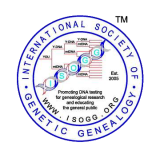Recombination
From ISOGG Wiki
Recombination is the exchange of DNA segments between the two copies of a chromosome (maternally inherited and paternally inherited). This occurs during the creation of an egg or sperm for the next generation. Each chromosome is cut at the same location, usually at one or two random spots (crossover points), and DNA segments are swapped between the two copies.
The newly formed chromosome in the egg will be a patchwork of contributions from the maternal grandparents, and the newly formed chromosome in the sperm will be a patchwork of contributions from the paternal grandparents, but there is still one copy of every gene. Some eggs and sperm will retain a complete copy of one grandparent's chromosome without recombination. The creation of each egg and sperm is an independent event, so siblings will inherit different portions of their grandparents' DNA.
Males and females have different rates of recombination. Males average about 27 crossovers per child and females average about 41 crossovers per child.[1]
There are also genetic variations in recombination between populations.
Further reading
- Recombination: creating variation in gametes An illustrated article on the Genetics Suite website.
- Lobo I and Shaw K (2008). Thomas Hunt Morgan, genetic recombination and gene mapping . Nature Education 1(1):205.
- Autosomal DNA. A post by Tim Janzen on the Rootsweb Genealogy DNA mailing list on the subject of recombination.
Blog posts
- Segments: bottom up by Jim Bartlett, Segmentology, 24 May 2015.
- Recombination also evolves by Razib Khan The Unz Review, 18 January 2015.
- Autosomal testing: recombination by Steve Handy. DNA Genealogical Experiences and Tutorials blog, 3 November 2012.
- How do DNA segments get smaller? by Blaine Bettinger. The Genetic Genealogist, 31 January 2015.
Scientific papers
- Campbell CL, Furlotte NA, Eriksson N et al (2015). Escape from crossover interference increases with maternal age. Nature Communications 6; article number 6260 (subscription required).
- Weggman D, Kessner DE, Veeramah KR (2011). Recombination rates in admixed individuals identified by ancestry-based inference. Nature Reviews Genetics 20; 43(9) :847-853.
- Hussin J, Roy-Gagnon MH, Gendron R et al. Age-dependent recombination rates in human pedigrees. PLoS Genetics. 2011 Sep; 7(9): e1002251. Published online 2011 Sep 1.
- Hinch AG, Tandon A, Patterson N et al (2011). The landscape of recombination in African Americans. Nature 476(7359): 170-175.
- Kenneth P, Petkov P (2010). Mammalian recombination hot spot: properties, control and evolution. Nature Reviews Genetics 11: 221-233.
- Kong A et al (2010). Fine-scale recombination rate differences between sexes, populations and individuals Nature 467: 1099-1103. See also the addendum.
- Chowdhury R, Bois PRJ, Feingold E, Sherman SL, Cheung VG (2009). Genetic analysis of variation in human meiotic recombination. PLoS Genetics 2009 September; 5(9): e1000648.
- Fledel-Alon A, Wilson DJ, Broman K et al (2009). Broad-scale recombination patterns underlying proper disjunction in humans. PLoS Genetics 2009 September; 5(9): e1000658.
- Myers S, Freeman C, Auton A et al. A common sequence motif associated with recombination hot spots and genome instability in humans. Nature Genetics 40; 1124-1129.
- Coop G et al (2008). High resolution mapping of crossovers reveals extensive variation in fine-scale recombination patterns among humans. Science 319: 1395-1398.
- Kong G et al (2008). "Sequence variants in the RNF212 gene associate with genome-wide recombination rate. Science 319: 1398-1401.
- Gabriel S et al (2002). The structure of haplotype blocks in the human genome. Science 296: 2225-2229.
- Kong A et al (2002). A high-resolution recombination map of the human genome. Nature Genetics 31: 241-247.
See also
- Autosomal DNA
- Autosomal DNA statistics
- Chromosome Browser Examples
- Identical by descent
- Meiosis
- Mitosis
References
- ↑ Chowdhury R, Bois PRJ, Feingold E, Sherman SL, Cheung VG (2009). Genetic analysis of variation in human meiotic recombination. PLoS Genetics 2009 September; 5(9): e1000648.

